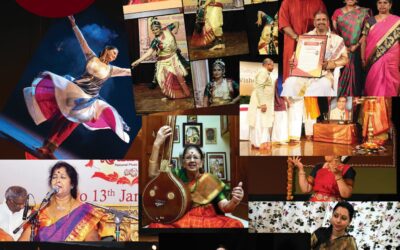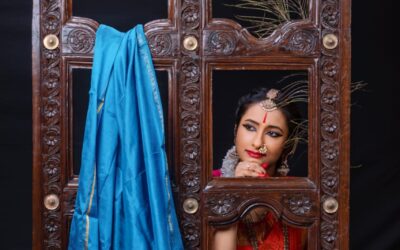What to expect from the Arts?- 1
– Arun Sreenivasan
Exquisite, is probably the closest possible word that can be associated with the Arts. It is marvellous that an artiste can carry to a different world altogether within a span of seconds- a world of fantastical experience! As artistes and enthusiasts, we know that this experience is not a mere inkling or an excitement which might dwindle after a while, but an unexplainable Joy– a kind of a positive force and energy which fills our heart and mind uncontrollably throughout. The “want” or “yearning” of this Joy makes us go back to it, time and again and we are never exhausted. This Joy is termed as Ānanda in Sanskrit Poetics. This Joy is not a passive veil which nullifies or numbs our sensitivities; we are very much aware and clear during Art Experience. Art Experience is a celebration of senses and not a dark curb of it.
Different people like and practice the Arts for different reasons, for some it is a passionate hobby, for somebody else it is a means of livelihood and for someone it might simply be a pass of time and many reasons more. However, all of it primarily starts with the reason, ‘because it makes me happy’. Knowingly or unknowingly we would have gone back to it because it made us happy the first or the previous time we pursued it. An interesting range of questions occur here, if we ask ourselves-
Why does this happen? Meaning, why did dance, music or painting or poetry attract me particularly? What makes me practice and pursue it? What makes me choose the art form over other things? These set of questions, might sound different for an artiste and an enthusiast, they are but one- What am I expecting from it? Or, Am I expecting anything from it?
There are numerous discussions and works in the tradition of Sanskrit Poetics or Alaṅkāraśāstra which seeks and answers the question- What should be expected from Arts? Scholars like Prof. M Hiriyanna, Prof. T N Sreekantaiyya and Śatāvadhāni Dr. R Ganesh have discussed about this in great detail they greatly agree and conclude in the lines of the traditional Indian thought- Art has no purpose and it stands for itself. What does this mean? Arts do not contribute to the matrices of the world; the socio-political or economic status of a country does not depend on the nature of Art. For example, whether the currency rate of dollar vs. rupees is constant or varying has no effect and impact on the Arts.
It is important here to not confuse ourselves between Spirit and System. The understanding of Arts as profession with its norms and structures is different from the nature of Arts in spirit. When something becomes a profession, especially subjects of Humanities, certain norms are to be formed for better functioning- however, this does not change the spirit of it.
Coming back to our question about the expectation from Arts, the tradition has presupposed this with the understanding of the nature of the Art. This is important because, once we understand the nature, can we address the expectation factor and everything related to it.
Art is something which is essentially ‘created’ by the poet. The mode and the medium are framed by the poet for the purpose of the expression of the vastu (plot/theme- which is also a result of the imagination of the poet) (kavehe karma kāvyam, says Kuntaka in Vakroktijīvita) However, we willingly accept this and move ahead to enjoy the beautiful creation of work with myriad emotions. This is because, although the created/expressed piece of work is made-up and make-believe, the content is a reflection of our intellect and life-experiences; the medium and the characters might be pretence, but the emotions are very much real. The content is a mirror of life. For example, we might not relate or might not know the characters of a mother and a daughter on stage or in a painting, but we passionately associate with “Motherhood” and “Daughterhood” and appreciate the value and enjoy. Similarly, Rāmāyaṇa is not merely a kidnap story, but we appreciate Rāmāyaṇa for its value and beauty. The generosity and unselfishness of Rāma, Hanumanta-s benevolence, Sītā-s patience and determination, Lakṣmaṇa-s devotion, willing servitude and mindless impatience, Rāvaṇa-s arrogance and idiocy, Vibhiṣaṇa-s sense of Dharma, are all but an inspiration for us! Don’t we traits of a Rāma or a Sītā or a Hanumanta around us in our neighbourhood and people we know? Don’t we associate ourselves or people with characters and plots which has given us immense joy and inspired us in our everyday life? It is this quality which makes us love it more.
With respect to the Art Experience, there are two schools of thought which understand Art Experience, slightly differently. The Realistic School of Philosophy (Sāṅkhya and Nyāya schools mainly) understand Art as, a sort of a break from the monotony of routine life, however momentary it might be. A kind of a relief from our usual monotonous activities. A pause to reality called Life.
The Idealistic School of Philosophy (Vedānta School) believe that Art is only a sublimation of reality and not an escape. We cannot run away from the world, but we can certainly change our attitude and feelings towards it. It is not a deviation but an acceptance, which makes us realise the Beauty. The final opinion or dictum in Indian Thought is that, Art is not an escape from reality and Art is not an addiction in the sense of vice, but a contemplation of the same world. Śatāvadhāni Dr. R Ganesh says, Art cannot promise a sound and healthy society where all the negatives are eradicated, but by Art Experience, these things may happen as by-products. Thus, impact of Art is a lasting charm of Life.
The purpose of Arts is not to create an illusion or a make-believe imagination. Arts do not shun the world but embrace it. The world with all its Sukhaduḥkhātmaka factors which are triggered by the Ariṣaḍvarga-s (Kāma, Krodha, Lobha, Moha, Mada and Matsara) act as tools for the poet. Bhaṭṭa Tauta, poet, philosopher and a scholar of Alaṅkāraśāstra from Kashmir says, just like how ash (which is dirt and waste) is used to clean a dirty mirror for a clear view, the same is it with Arts. Let us understand more about it, and the nature of Arts in the next section of our discussion.
Until next time.
**********



